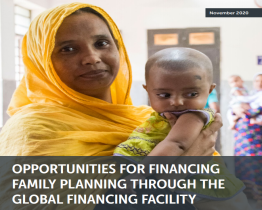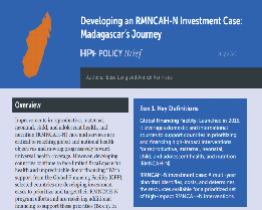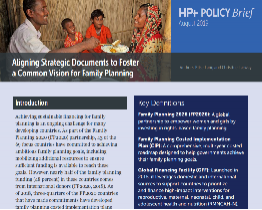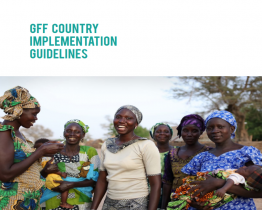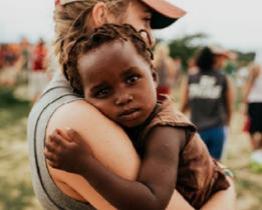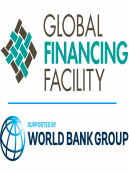 The Global Financing Facility (GFF) is a partnership whose purpose is to fill the funding gap for reproductive, maternal, newborn, child, and adolescent health and nutrition (RMNCAH-N) in 67 high-burden, low- and lower middle-income countries. In line with the Every Woman Every Child movement and in support of the Global Strategy for Women’s, Children’s and Adolescents’ Health (2016–2030), the GFF was launched at the Third International Financing for Development Conference in Addis Ababa, Ethiopia, in July 2015, by a partnership comprising governments, civil society organizations, the private sector, UN agencies, GAVI, and the Global Fund for AIDS, TB, and Malaria.
The Global Financing Facility (GFF) is a partnership whose purpose is to fill the funding gap for reproductive, maternal, newborn, child, and adolescent health and nutrition (RMNCAH-N) in 67 high-burden, low- and lower middle-income countries. In line with the Every Woman Every Child movement and in support of the Global Strategy for Women’s, Children’s and Adolescents’ Health (2016–2030), the GFF was launched at the Third International Financing for Development Conference in Addis Ababa, Ethiopia, in July 2015, by a partnership comprising governments, civil society organizations, the private sector, UN agencies, GAVI, and the Global Fund for AIDS, TB, and Malaria.
The GFF aims to shift the focus away from sole reliance on official development assistance to an approach that maximizes use of existing resources and increases overall funding for RMNCAH-N across multiple funding sources. The GFF will achieve this through a dedicated multidonor trust fund (the GFF Trust Fund), financing from the International Development Association (IDA) and the International Bank of Reconstruction and Development (IBRD), the “crowding in” of additional domestic and external resources, and supporting alignment of donor financing (Figure 1). The GFF is coordinated by a secretariat based at the World Bank, which manages the GFF Trust Fund and supports GFF processes in country, and an investors group, a broad group of stakeholders that convenes several times a year to discuss progress.
Figure 1. The GFF Financing Platform
Additional grants available to countries for RMNCAH-N that are linked to IDA or IBRD projects. The governments of Canada, Norway, and the United Kingdom; and the Bill and Melinda Gates Foundation have made contributions to the GFF Trust Fund.
IDA and IBRD are World Bank institutions that offer different types of financing to low- and middle-income countries. IBRD offers loans primarily to middle-income countries at interest rates comparable to market rates. IDA provides concessional loans (credits) at low interest rates, grants, and debt relief to the world’s poorest countries. Under GFF, a portion of IDA/IBRD grants and loans should be used to finance RMNCAH-N.
Domestic resources include financing for RMNCAH-N from both the government and private sector in the country. External resources include aligned resources from private organizations, foundations, and governments that do not contribute directly to the GFF Trust Fund, including USAID funding.
The GFF selects interested countries in waves based on need, as expressed in “country investment cases,” and in alignment with IDA and IBRD loans. As of March 2018, 26 countries are in the startup, design, or implementation phases. Unlike other financing mechanisms, the GFF countries do not need to complete a standalone application process to be selected to receive funding. The GFF makes Trust Fund allocation decisions based on set criteria, including a country’s disease burden, income status, financing gap, and commitments to using IDA/IBRD financing and domestic resources for RMNCAH. Figure 2 shows the start year and approved financing from the GFF Trust Fund and IDA/IBRD for the 26 countries.
Why is the GFF important for family planning?
As a multistakeholder, country-driven partnership and financing platform, the GFF could potentially provide additional funding for family planning. Every GFF-supported country develops an RMNCAH-N investment case, a three-to-five-year costed plan that prioritizes RMNCAH-N activities based on the country’s context and available funding. The investment cases lay out how GFF funding will be used in line with IDA/IBRD loans, other RMNCAH-N financing, and stakeholder agreements to implement high-impact, cost-effective activities that will contribute to lowering maternal and child mortality rates.
Family planning, as a high-impact, cost-effective intervention, is included in many countries’ investment cases; however, the degree of emphasis on family planning varies by country. As of March 2018, Cameroon,Democratic Republic of Congo,Ethiopia, Kenya, Liberia, Mozambique, Tanzania, and Uganda have publicly available investment cases. While all investment cases include family planning interventions and indicators, only Cameroon, Ethiopia, and Kenya have specified improved family planning outcomes as a development objective of GFF funding. Further, only a few countries include interventions to improve contraceptive procurement in their investment cases.
Kenya aims to increase long-acting family planning methods, particularly among youth, and permanent family planning methods for women who have finished childbearing. The GFF investment case highlights several immediate actions to reach these goals, including improving distribution of family planning commodities to increase access, scaling up youth-friendly health services, a voucher scheme to reach adolescents, and training pharmacy staff to provide family planning methods. The family planning activities are estimated to cost $US167 million over five years, 6 percent of the total cost of the investment case. The World Bank project appraisal document for GFF funding in Kenya includes funding for RMNCAH strategic commodities, especially family planning commodities.
Cameroon prioritizes family planning in its investment case. Cameroon’s goal is to increase the contraceptive prevalence rate for married women of reproductive age by at least 30 percent in four of 10 regions. The interventions include behavior change interventions, integration of family planning with other services, introduction of community-based delivery of injectables, and social marketing. Cameroon’s project appraisal document indicates that family planning will be included in the GFF-supported performance-based financing scheme through subsidies for new or existing family planning visits at the secondary care level. Overall, 16 percent of the US$82.4 million estimated cost is allocated for family planning interventions. Funding for contraceptive procurement is not included.
Even if family planning is prioritized in a RMNCAH-N investment case, it may not always translate into increased funding for family planning. GFF funding is more likely to succeed when the investment cases also incentivize (“crowd in”) additional funding commitments for family planning from other domestic and external sources. According to a review conducted by PAI, project appraisal documents (PADs) that describe activities being funded through GFF in each country are not necessarily aligned with the priority activities in the countries’ RMNCAH-N investment cases, even though a main goal of the investment case is to determine how GFF funding will be used. For example, the RMNCAH-N investment case for Tanzania includes objectives on family planning and contraceptive procurement, yet there is no mention of GFF funding for family planning or contraceptive procurement in the PAD. These misalignments suggest family planning may not receive direct support from the GFF and could remain underfunded in a country, even if it is prioritized in investment cases. However, broader health systems initiatives supported by GFF funding, such as results-based financing schemes, could include family planning. In this case, the activity would not be labeled or reported as a standalone family planning activity; it is thus unclear to what extent GFF funding will address family planning needs.
Resources
This document outlines Madagascar's experience in developing an investment case as part of a grant application for RMNCAH-N from the World
HP+ recently conducted a review of several countries' CIPs and GFF RMNCAH-N investment cases to examine how family planning priorities were
A 5-minute video about how the GFF is improving maternal and child health in Cameroon
A presentation by HP+ on best practices for developing an investment case for the GFF
A brief by PAI on how family planning is being prioritized in GFF investment cases and funding
A short article in the Lancet describing common misconceptions about the GFF


